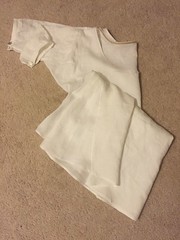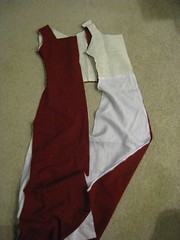The first finished object of 2015 is a humble shift. January's Challenge is Foundations, and I interpreted that as the thing that comes first, the base layer. After the fact, though, thinking about the inspiration more broadly, I still like my choice. In my experience, correct underwear is one of the things that help me achieve not just costumes, but historical clothing. I don't mean just in getting the look right, although there certainly is that, but also in mindset. When I'm dressed, this shift won't be seen at all. But I'll know.
This shift is based on the style from around 1770. I used simple geometric construction, and really the differences from a medieval version are minor. Construction was all machine, due to time constraints, and the finished result looks like a plain white shirt, exactly what it is. Seams are flat-felled and the neckline is finished by turning under and binding with a narrow linen tape. My favorite detail is the reproduction sleeve buttons, sourced from Wm. Booth, Draper. The buttonholes turned out fairly well, which I'm very pleased with since I have struggled with them in the past.
The Challenge: January - Foundations
Fabric: 1.5 yds handkerchief linen
Pattern: Online sources, primarily Mara Riley and Sharon Ann Burnston
Year: 1770s
Notions:1/4" linen tape, pewter buttons
How historically accurate is it: Middling. Pattern and materials are accurate, all-machine construction is not.
Total cost: Stash fabric, estimated value $25. Buttons, $9.
28 January 2015
12 January 2015
Biting off more than I can chew: Historical Sew Monthly!
I perpetually have the problem that my project ideas and ambitions vastly exceed my available time to work on them. This is only exacerbated by the fact that I enjoy planning and starting projects more than finishing them. At the same time, though, I love challenges and pushing myself. And this year, I want to dip my toes into the water of the Historical Sew Monthly. I have no idea how I'm going to add these things onto my already full plate, but having concrete goals is seriously motivating. The first step is try to match up project ideas with different months. In addition to the set themes, my overall goals for participating this year are to work from stash when possible, and to do projects from my someday/maybe list. Not necessarily things I would have sewn anyway, but ideas I've daydreamed about that deserve to actually happen, and new skills or eras I've wanted to learn.
- January - Foundations: You can never have too many chemises. I can think of at least 3 styles for which I don't have enough (or in one case, any!) linens.
- February - Colour Challenge Blue: This could go any number of ways. I need to look through the stash to see what blues I have (blue is one of my favorites, so the question is not whether, but how much). I also have a much-loved blue dress that needs to be seriously re-done if I want to wear it again.
- March - Stashbusting: Again, lots of options here. Tentatively, men's hosen in a gray wool-linen blend I have tons of.
- April - War & Peace: This one could be difficult for me; I don't have any ideas yet.
- May - Practicality: I've been meaning to make a lightweight wool tunic that goes with my rust sleeveless surcoat. Simple and practical if ever anything was.
- June - Out of Your Comfort Zone: My first thought is to build on the hosen from March and work on more menswear. I also have some ideas for new skills - mostly revolving around accessories, and some non-clothing textiles
- July - Accessorize: As the date gets closer, I'll need to evaluate whether I'll be able to make the deadline, but I want to finish the brick stitch pouch that I started last year.
- August - Heirlooms & Heritage: This is an interesting one - I mentally associate heirloom sewing with much more recent history (say, 1800-1950) than the period I usually do. Maybe this is an excuse to branch out into the Victorian bustle styles I so admire?
- September - Colour Challenge Brown:I've just made a dress out of what I think is the only brown I had in the stash, so that won't do. I think I'll start watching for nice brown fabrics, and base the project around what I find.
- October - Sewing Secrets: I'd like to do another German 16th c. dress, with slits hidden in the pleats to reach a pouch hidden under the skirt.
- November - Silver Screen: Step one is to watch a bunch of movies, since I've never seen many of the period classics!
- December - Re-do: The most likely candidates here are Stashbusting and Practicality... or both at once.
05 January 2015
Red overgown, first fitting

Overgown back pleats
Originally uploaded by Catrijn.

Testing fit of overgown
Originally uploaded by Catrijn.
Labels:
15th c.,
Continental early Tudor
02 January 2015
Getting the ball rolling on the red overgown
The continental 1490's project has been languishing while I searched high and low for a lining fabric. I wanted something white or off-white, heavy enough to not be sheer, in natural fibers, preferably wool, priced such that I could afford to do a full lining. This was not to be. Plan B is to embrace the medieval mindset and work with what I have. I'm going to interline with white linen, and then fake a richer lining of wool flannel at all the edges.
That decision gave me enough information to move forward. My primary fabric is a luscious red wool twill, in 2 remnants of 2 yards each. To maximize that limited resource, I cut pieces as I knew what shapes I needed, trying to leave the most usable yardage as I went. The bodice is cut from my kirtle pattern, with a bit of ease added but without the extra for folding into a strong lacing opening. This layer shouldn't be under stress, so that reinforcement isn't needed. In the back, I stopped it at the waist, just like the kirtle, but in the front I extended it all the way to the hem to remove the front waist seam. That seam still exists in the interlining, though, since I wanted to transition from heavier linen in the bodice to lightweight linen in the skirt. The photo shows this rather unusual construction order - I plan to draft the sleeves next, leaving the skirt back for absolute last, since that will be a simple rectangle, as big as I can make it at that point.
That decision gave me enough information to move forward. My primary fabric is a luscious red wool twill, in 2 remnants of 2 yards each. To maximize that limited resource, I cut pieces as I knew what shapes I needed, trying to leave the most usable yardage as I went. The bodice is cut from my kirtle pattern, with a bit of ease added but without the extra for folding into a strong lacing opening. This layer shouldn't be under stress, so that reinforcement isn't needed. In the back, I stopped it at the waist, just like the kirtle, but in the front I extended it all the way to the hem to remove the front waist seam. That seam still exists in the interlining, though, since I wanted to transition from heavier linen in the bodice to lightweight linen in the skirt. The photo shows this rather unusual construction order - I plan to draft the sleeves next, leaving the skirt back for absolute last, since that will be a simple rectangle, as big as I can make it at that point.
Subscribe to:
Posts (Atom)

